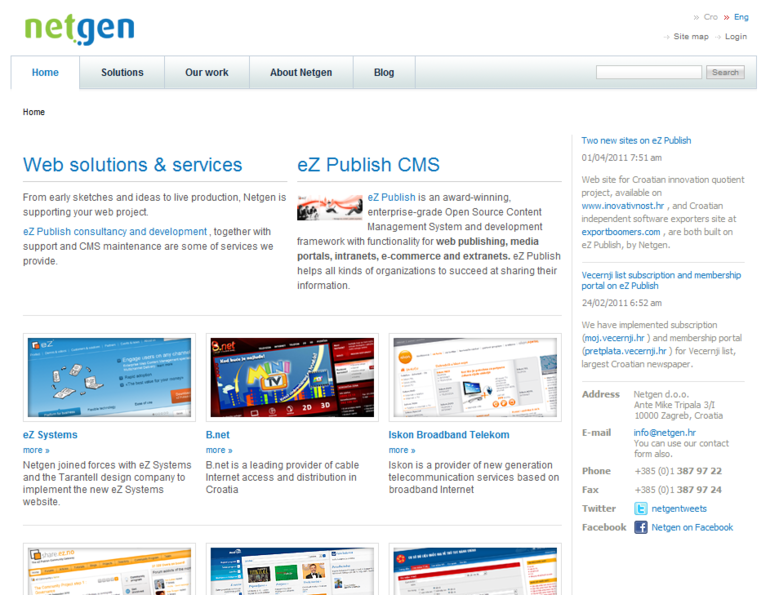We at Netgen, as a web development company, are facing the same challenges on every web project we do. It is very important to know how to deal with these challenges to successfully manage a web project. We plan to publish a series of blog posts describing the steps we take when creating a modern web site.
A modern web site is not just a question of a trendy design, more important is the content, how its created, managed, searched, delivered, shared, etc.
So this blog series is mostly aimed to help understand the complex web creation work-flow, from the first idea to the final result and beyond. Fellow colleagues in web industry will probably be familiar with large part of the topic, but could find some interesting stuff to use on their own projects. General public will have a sneak peek in our every day business and challenges we face.
First post will cover the very first things what you need to know when starting a web project whether you are a web agency or a web site founder. Also, at the end of each post we will give a real life example: our own web site revamp project.
Also to note that our web projects are almost 100% based on a content management system (usually eZ Publish CMS) so this topic will describe a process to create such a site, but most things can be applied to other web projects in a similar way.
The Idea
Netgen web revamp example
As mentioned in the intro, we are currently starting a revamp of our web site. So we will play the usual game: “Netgen X” as a web agency is asking “Netgen Y” as a client few questions:
Netgen X:
- So guys, tell us why are you doing this redesign of your website?
Netgen Y:
- We want to build our brand as web development company further. We want to present our services more precisely, especially for the potential customers outside of Croatia.The main purpose of the redesign is to generate more informed contacts and business opportunities.
Netgen X:
- Who are you addressing with your new web site?
Netgen Y:
- potential customers looking for a complete web solution
- potential clients and partners looking for eZ consultancy & know how
- potential eZ Publish web site owners looking for “evolution” (maintenance)
Netgen X:
- And how will you communicate with them?
Netgen Y:
- we are reliable partner for your web project, from creation through implementation to “evolution” (maintenance)
- successfully implementing web sites on top of one of the best open source CMS
- giving great value for money, even more
- we are working globally
Netgen X:
Sounds good, but what do you expect them to do?
Netgen Y:
- request a quote for a new project
- request a quote for supporting an existing project
- schedule a 15min Skype talk
- ask a question about our services
- use networking tools: Tweet button, subscribe to RSS, etc.
Netgen X:
Clear enough, you seem to know what you are doing?
Netgen Y:
That is because you are asking the right questions and we knew them before :)
Usually a web projects start when someone gets an idea. Bingo! If he or she, the web founder, isn’t a web developer, next step would be to go to a web agency and shout “I want a super cool web site with modern look, shiny colors and... and a ‘like’ button!”. In that moment it is good for all parties involved to take a few deep breaths and then establish a baseline for further communication in the project.
The Why
The first question for the web founder would be: “Why are you doing this web site?”. There are more variants of the same question: “What are the main business objectives that the new and shiny website needs to fulfill? How is your business going to benefit from this website?”. Of course, in some cases this matter is simple and obvious. A media company would need a web site to deliver the news. A retail business would want to sell their products. A manufacturer would want to promote their products and give the retailers a b2b interface. In these cases “The Why” should not be a problem as the objective is clear enough and the main idea of the web is leaned on some existing venture or brand.
Though, in some cases, the answer happens to be: “because I want to be on Internet” or “my nephew told me it is a modern thing to do” or “all my competitors have a website”. It is wise to setup a baseline and not go further with the project until the answer to “The Why” is not perfectly clear to both sides (otherwise the project should never start).
The same advice applies for projects which are not in relation with some existing business, where people try to build a business with only a web site and usually are a one-man band. In these cases reality check is highly recommended and the baseline can be used for that.
The Baseline
Usually people have some notion of what the content of the web should be. People who know “The Why” usually have some clue on who their target audience is and what are the main messages. Still, establishing a baseline could always help at later stages. For other cases, the baseline is necessary, the ones who do not know why certainly don’t have a clue who is their potential audience, what to communicate with that audience and how to persuade them to act.
To get to a common baseline, you will need answers to 3 simple but important questions:
- Who is the audience? If the web is on Internet, they may say that the audience is everybody who is online, but it is wise to target some group or groups. It is not possible to communicate in the same way with young geeky male developers as with middle aged women.
- What are the main messages to be presented on the web? The answer should be a bulleted list up to five sentences. Rule of thumb is to keep it as simple as possible so your audience can understand it easily. Those messages strongly depend on the audience you are targeting, so keep that in mind when writing to them. These answers are not intended to be a copy-write text, just to summarize the wanted communication.
- What actions or goals you want to be executed by the audience? Even if you have the simplest possible page it will still probably have a phone number or an email shown, so the action would be the contact. If you don’t have the contact action you need to ask your self what is the purpose of the web. In the last years we see the rise of web engagement possibilities, so even pure reading web sites have actions like tweet buttons and Facebook “Like”. So you need some sort of action to be taken by your audience. And you need to present them optimally on the web, as well as measure them afterwards, to see how your web is performing.
I personally found these answers to be the absolute minimum when speaking to a potential client. If he does not know them, the project will be in trouble sooner or later.
Usually, to write an project idea, main reasons behind it and list the answers for baseline questions, you will need just one page of paper, maybe two. So don’t skip this phase, it will save you a lot of time and headaches later on.
In the next step we will cover a web site map definition and why it is important.
Photo credit: Designed by Freepik

